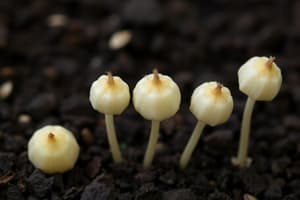Podcast
Questions and Answers
What is the purpose of soaking seeds in hot water followed by cold water for 24 hours?
What is the purpose of soaking seeds in hot water followed by cold water for 24 hours?
- To enhance the germination rate immediately
- To facilitate the removal of inhibitors (correct)
- To fully hydrate the seeds
- To promote acidification of the seed coat
Which chemical is used for soaking seeds to modify a hard or impermeable seed covering?
Which chemical is used for soaking seeds to modify a hard or impermeable seed covering?
- Potassium nitrate
- Thiourea
- Sulphuric acid (correct)
- Gibberellic acid
What is cold stratification primarily used for?
What is cold stratification primarily used for?
- To increase seed dormancy
- To accelerate the drying process
- To stimulate physiological changes within the seed embryo (correct)
- To prevent moisture loss
What type of environment is required during cold stratification?
What type of environment is required during cold stratification?
How long can post-harvest dormancy last in freshly harvested seeds stored under dry conditions?
How long can post-harvest dormancy last in freshly harvested seeds stored under dry conditions?
Which treatment has been found to stimulate germination in many citrus species?
Which treatment has been found to stimulate germination in many citrus species?
What should be done to seeds after acid treatment to ensure safety?
What should be done to seeds after acid treatment to ensure safety?
What is the main role of endogenous growth promoting substances during cold stratification?
What is the main role of endogenous growth promoting substances during cold stratification?
What does dormancy in seeds primarily help to conserve?
What does dormancy in seeds primarily help to conserve?
Which type of dormancy is characterized by hard seed coats that prevent germination?
Which type of dormancy is characterized by hard seed coats that prevent germination?
Which method involves breaking or scratching the seed coats to aid germination?
Which method involves breaking or scratching the seed coats to aid germination?
What is a factor that does NOT contribute to seed dormancy?
What is a factor that does NOT contribute to seed dormancy?
Which type of dormancy requires several weeks to months after harvest for the embryo to mature?
Which type of dormancy requires several weeks to months after harvest for the embryo to mature?
How can chemical inhibitors in seeds be reduced to allow for germination?
How can chemical inhibitors in seeds be reduced to allow for germination?
Which of the following is NOT a method to overcome seed dormancy?
Which of the following is NOT a method to overcome seed dormancy?
What is double dormancy in seeds?
What is double dormancy in seeds?
Flashcards are hidden until you start studying
Study Notes
Dormancy
- Dormancy is a state of suspended growth and development in organisms. It helps conserve energy.
- Dormancy is a natural survival mechanism, not a failure.
Types of seed dormancy
- Seed coat dormancy: The seed coat is hard and impermeable, preventing germination. Examples: Malvaceae, Pits of stone fruits, shells of nuts
- Dormancy due to rudimentary embryos: The embryo is not fully developed at the time of seed dispersal. It requires time to mature before it can germinate. Examples: Pinus species, palms
- Dormancy due to chemical inhibitors: Seeds contain chemicals that inhibit germination. These inhibitors can be leached out with water or adsorbed by water.
- Dormancy due to internal factors: The embryo is physiologically dormant and requires specific conditions, such as moist chilling treatments, to resume growth. Examples: Freshly harvested seeds of apple, grapes, peach, and apricot
- Double dormancy: Seeds exhibit both seed coat dormancy and embryo dormancy. Example: Cercis occidentals
Overcoming Dormancy
- Mechanical scarification: Physically breaking or scratching the seed coat to make it permeable.
- Soaking in water: Softening the seed coat and washing away inhibitors.
- Acid treatment: Modifying the seed coat using concentrated hydrochloric acid or sulfuric acid for a brief period.
- Cold stratification: Exposing seeds to moisture, oxygen, and cool temperatures to promote physiological changes in the embryo. This process involves placing seeds in a moist medium like sand, peat, or vermiculite and storing them at slightly above freezing temperatures for an extended period, usually one to four months.
- Dry storage: Promoting after-ripening in dormant seeds.
- Treatment with chemicals: Soaking seeds in solutions of potassium nitrate, gibberellic acid, or thiourea to stimulate germination.
Studying That Suits You
Use AI to generate personalized quizzes and flashcards to suit your learning preferences.




